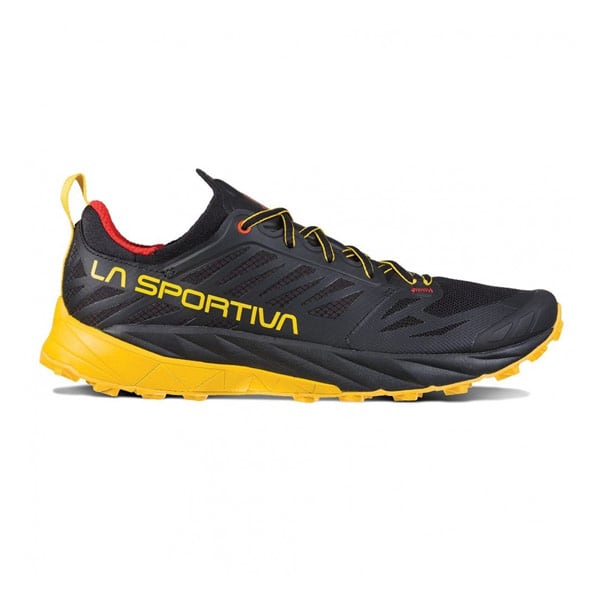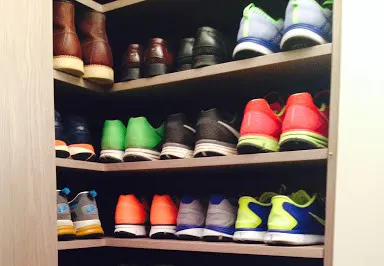“Che scarpe mi metto oggi?”
Tutte le nostre corse iniziano più o meno così, mentre ci troviamo di fronte al nostro personalissimo reparto scarpe da running.
Alcuni di noi sicuramente possono fare concorrenza ad un negozio per la quantità di scarpe posseduta, altri invece prima di comprare un nuovo paio aspettano che si completi il ciclo di decomposizione della scarpa!
Possiamo affermare con buona approsimazione che il numero ideale di scarpe da alternare sia tre: guarda caso, il numero perfetto.
Ideale perchè, a seconda dell’attività da svolgere o del percorso da affrontare, potremo sempre scegliere il modello più adatto.
Ma quanti tipi diversi di scarpe esistono? O meglio, quali sono le categorie?
Esiste una classificazione, ormai datata e vecchia come l’età del bronzo, che ci permette tuttavia di distinguere fra le varie categorie di scarpe: una sorta di linea guida per orientarsi in questo sterminato mondo. Chi di noi non ha mai sentito parlare di A2, A3, ecc?
Andiamo pertanto ad esplorare queste diverse categorie e a comprendere infine come mai esse siano ormai superate.
Partendo dal livello più basso, A0, ma che noi preferiamo chiamare minimalista, ci troviamo di fronte a scarpe generalmente poco o addirittura non ammortizzate, con un differenziale (differenza di altezza tacco-punta) prossimo allo zero, quasi a voler adattare il piede alla corsa più naturale possibile, quella del barefoot (“a piedi nudi”). Favoriscono quindi il movimento naturale delle articolazioni, aiutano a mantenere una posizione biomeccanica ottimale del piede e a correggere alcuni problemi di postura. Di contro, sollecitano tendini e legamenti e non sono pertanto adatte a chiunque e comunque non per lunghe distanze. Per queste calzature è necessario un periodo di adattamento più o meno lungo, per evitare di incappare in fastidiosi infortuni.

Esistono poi le superleggere, o A1, ideali per ritmi elevati e distanze medio-corte. Le classiche scarpe da gara: leggere (anche sotto i 200 grammi), reattive, elastiche e generalmente poco ammortizzate, favoriscono le nostre migliori performance e vanno utilizzate esclusivamente per correre ad alta velocità. Tendenzialmente dal drop basso (sui 4 mm), sono ideali per pesi non troppo elevati e per ritmi sotto i 3’45”/km. Evitiamo pertanto di sfoggiarle nelle classiche passeggiate domenicali post corsa!
-

Salming Race 7 -

Saucony Fastwitch 9 -

Hoka Evo Carbon Rocket
Proseguiamo quindi con le intermedie, le A2. Una categoria ampia e variegata, perchè in questo caso le sfumature sono molteplici, a partire da peso, reattività e ammortizzazione. Le più leggere si attestano sui 200 grammi, mentre le più pesanti comunque non superano i 260. Rappresentano in linea generale un buon compromesso tra reattività e ammortizzazione e possono talvolta contenere un lieve supporto antipronazione. Sono ideali per gare a ritmo non indiavolato e allenamenti che diano un po’ di brio e piacere di corsa. Drop in questo caso vario, possiamo trovarlo sia basso che alto.
-

Saucony Kinvara 11 -

Hoka Carbon X -

Brooks Launch 7
Ma veniamo alla categoria sicuramente più rappresentata, ovvero quella delle super ammortizzate (A3). Qui abbiamo una vastità di prodotti difficilmente contrastabile, e il motivo è semplice: sono le più richieste e le più sfruttate. Si aggirano attorno ai 300 grammi di peso (ma non è raro trovare qualche esemplare anche ben più leggero) e si distinguono per la loro morbidezza, il loro comfort e la massima ammortizzazione. Ideali per lunghe distanze, consentono di mantenere un buon livello di comodità anche dopo numerosi km e con pesi elevati. Sono inoltre le più longeve: se durano meno di 500-600 km vuol dire che non sono di buona qualità o che abbiamo scelto un modello particolarmente sfortunato. Di solito hanno un drop elevato (intorno ai 10 mm).
-

Brooks Glycerin 17 -

Saucony Triumph 17 -

Hoka Bondi 6
The category of super-cushioned shoes, but with anti-pronation support, is called stable (A4). They are also very popular and, like the super-cushioned shoes, weigh around 300 grams. They are called stable because they allow even footing even for those who have a tendency to pronate, i.e. those who have flat feet and bend and wear shoes from the inside. In many cases one can see under the sole of the shoes the so-called stability support, a plastic insert that literally ‘guides’ the foot’s stance, while they generally have a more or less marked arch support on the inside. They represent the most protective category .
-

Saucony Liberty ISO 2 -

Brooks Transcend 7 -

Hoka Gaviota 2
If, on the other hand, we want to push off-road and tackle dirt tracks, grass and mountain paths, we will put trail shoes (A5) on our feet, those that allow us to obtain maximumgrip and traction on any type of terrain, even the most slippery and impervious. In this case, the spotlight is on the sole, which must have a design that does not trap dirt and mud and must be made of materials that ensure good grip even on wet or icy ground, on the midsole (good cushioning is preferable) and on the upper, which must be able to resist wear and tear, impacts with rocks and, in some cases, water (there are numerous waterproof gore-tex models).
-

Hoka Speedgoat 4 -

Saucony Peregrine 10 ST -

La Sportiva Kaptiva -

Brooks Cascadia 14
For track and cross-country enthusiasts, there are the spiked shoes (A7), which are very light, almost flat and extremely reactive and fast, with the characteristic spikes to guarantee maximum traction and efficiency when pushing.

As we said above, these categories are useful for getting a rough idea of the various shoe models, but they leave more and more time to be found, as the running shoe market is evolving rapidly and the differences between the various classes are becoming increasingly smaller. In fact, it is not uncommon to find very light shoes, even under 200 grams, but super-cushioned and, conversely, heavier but extremely responsive shoes. Even the so-called minimalists are not always light and poorly cushioned: they can often have a high level of cushioning, perhaps combined with a zero drop, i.e. as if you were standing on a slab of polystyrene under your feet.
This is why it is becoming increasingly difficult to enclose a shoe model, with all its characteristics and nuances, within a definition of a word or, even worse, an acronym and a number. We therefore invite you to be wary (in a healthy way, let’s be clear!) of a simple categorical definition: our suggestion is to always rely on experts or specialists who can present you with as complete and exhaustive an overview as possible of the shoes you intend to buy.
Because it is these that will make the difference between a positive experience, which will succeed in winning you over from the very first step, and a totally negative one, which can often lead you to dislike or even abandon the most beautiful discipline in the world: running.
And now that we know a little more...what shoes shall we wear today?
 ITA
ITA
 DEU
DEU
 FRA
FRA
 ESP
ESP




